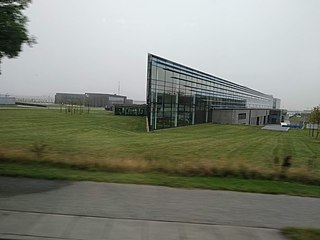
Vestas Wind Systems A/S is a Danish manufacturer, seller, installer, and servicer of wind turbines that was founded in 1945. The company operates manufacturing plants in Denmark, Germany, the Netherlands, Taiwan, India, Italy, Romania, the United Kingdom, Spain, Sweden, Norway, Australia, China, Brazil, Poland and the United States, and employs 29,000 people globally.
Doubly fed electric machines, also slip-ring generators, are electric motors or electric generators, where both the field magnet windings and armature windings are separately connected to equipment outside the machine.
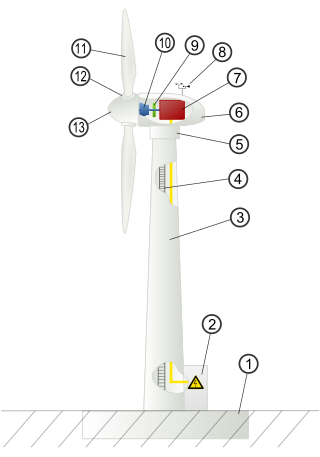
Wind turbine design is the process of defining the form and configuration of a wind turbine to extract energy from the wind. An installation consists of the systems needed to capture the wind's energy, point the turbine into the wind, convert mechanical rotation into electrical power, and other systems to start, stop, and control the turbine.
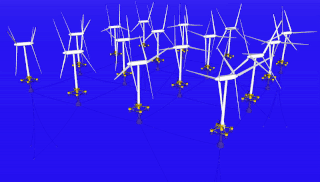
Unconventional wind turbines are those that differ significantly from the most common types in use.

Wind power in Germany is a growing industry. The installed capacity was 55.6 gigawatts (GW) at the end of 2017, with 5.2 GW from offshore installations. In 2020, 23.3% of the country's total electricity was generated through wind power, up from 6.2% in 2010 and 1.6% in 2000.
Siemens Gamesa Renewable Energy, S.A. was formed in 2017 in a merger of Siemens' Wind Power division with Gamesa Corporación Tecnológica, S.A.; it is a Spanish-German wind engineering company based in Zamudio, Biscay, Spain. The company has two other main sites in Spain: one in Madrid and the other in Sarriguren. Other than its headquarters, its onshore business is primarily based in Spain, while the offshore business is based in Germany and Denmark. It is the world's second largest wind turbine manufacturer behind Vestas.

Wind power generates about 10% of Turkey's electricity, mainly in the west in the Aegean and Marmara regions, and is gradually becoming a larger share of renewable energy in the country. As of 2024, Turkey has 12 gigawatts (GW) of wind turbines. The Energy Ministry plans to have almost 30 GW by 2035, including 5 GW offshore.

DeWind was an internationally active producer of wind power plants, originating in Germany. The company was founded in 1995 as Private Limited Company (GmbH) in Luebeck, Germany by seven shareholders. Five of them actively worked in the company. In 2002 the founders sold 100% of the shares to FKI Plc, Loughborough, UK. Nowadays it is based in Irving, Texas, and Hamburg, Germany. DeWind has the legal form of a corporation, and, since September 2009, it has been a subsidiary company of Daewoo Shipbuilding and Marine Engineering (DSME), a large shipbuilder based in Korea. Manufacturing takes place in Lübeck and Round Rock, Texas.
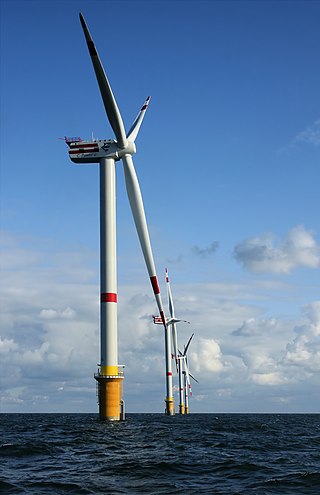
A wind turbine is a device that converts the kinetic energy of wind into electrical energy. As of 2020, hundreds of thousands of large turbines, in installations known as wind farms, were generating over 650 gigawatts of power, with 60 GW added each year. Wind turbines are an increasingly important source of intermittent renewable energy, and are used in many countries to lower energy costs and reduce reliance on fossil fuels. One study claimed that, as of 2009, wind had the "lowest relative greenhouse gas emissions, the least water consumption demands and the most favorable social impacts" compared to photovoltaic, hydro, geothermal, coal and gas energy sources.
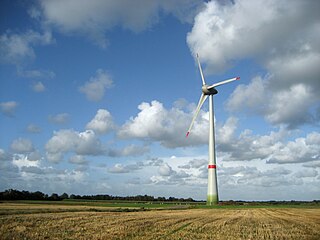
The Enercon E-126 is an onshore wind turbine model manufactured by the German company Enercon. With a hub height of 135 m (443 ft), rotor diameter of 126 m (413 ft) and a total height of 198 m (650 ft), the turbine can generate up to 7.58 megawatts of power, making it the largest wind turbine in the world for several years, until it was overtaken in 2014 by the Danish company Vestas with their V164-8.0 turbine. Their model number is a reference to their rotor diameter.

The Ormonde Wind Farm is a wind farm west of Barrow-in-Furness in the Irish Sea. The wind farm covers an area of 8.7 square kilometres (3.4 sq mi). It has a total capacity of 150 MW and is expected to produce around 500 GWh of electricity per year.
GE Offshore Wind is a joint venture with Alstom and a subsidiary of GE Renewable Energy, created in 2015 when most of Alstom's electrical power and generation assets were acquired by General Electric. GE's stake in the joint venture is 50% plus 1 share.
GE Wind Energy is a branch of GE Renewable Energy, a subsidiary of General Electric. The company manufactures and sells wind turbines to the international market. In 2018, GE was the fourth largest wind turbine manufacturer in the world.
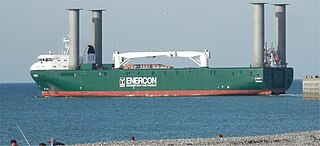
The E-Ship 1 is a roll-on/lift-off (RoLo) cargo ship that made its first voyage with cargo in August 2010. The ship is owned by the third-largest wind turbine manufacturer, Germany's Enercon GmbH. It is used to transport wind turbine components. The E-Ship 1 is a Flettner ship: four large rotorsails that rise from its deck are rotated via a mechanical linkage to the ship's propellers. The sails, or Flettner rotors, aid the ship's propulsion by means of the Magnus effect – the perpendicular force that is exerted on a spinning body moving through a fluid stream.

Starting in 1975, NASA managed a program for the United States Department of Energy and the United States Department of Interior to develop utility-scale wind turbines for electric power, in response to the increase in oil prices. A number of the world's largest wind turbines were developed and tested under this pioneering program. The program was an attempt to leap well beyond the then-current state of the art of wind turbine generators, and developed a number of technologies later adopted by the wind turbine industry. The development of the commercial industry however was delayed by a significant decrease in competing energy prices during the 1980s.

The Delabole wind farm was the first commercial onshore wind farm built in the United Kingdom, in November 1991. This field of wind turbines was initially developed by Windelectric Management Ltd.

The great majority of wind turbines around the world belong to individuals or corporations who use them to generate electric power or to perform mechanical work. As such, wind turbines are primarily designed to be working devices. However, the large size and height above surroundings of modern industrial wind turbines, combined with their moving rotors, often makes them among the most conspicuous objects in their areas. A few localities have exploited the attention-getting nature of wind turbines by placing them on public display, either with visitor centers on their bases, or with viewing areas farther away. The wind turbines themselves are generally of conventional horizontal-axis, three-bladed design, and generate power to feed electrical grids, but they also serve the unconventional roles of technology demonstration, public relations, and education.
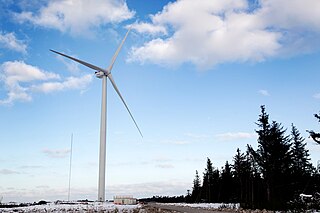
The Vestas V164 is a three-bladed offshore wind turbine, produced by Vestas, with a nameplate capacity of up to 10 megawatts, a world record. Vestas revealed the V164's design in 2011 with the first prototype unit operated at Østerild in northern Denmark in January 2014. The first industrial units were installed in 2016 at Burbo Bank, off the west coast of the United Kingdom. By 2021, Vestas had produced 500 of the series.
Seawind Ocean Technology B.V., a Netherlands based company, is a manufacturer (OEM) of integrated floating wind turbine and green hydrogen systems. Seawind is developing two-bladed floating wind turbines suitable for installation in all seas, including hurricane regions and ultra-deep waters. Founded on original research and development work by NASA, Hamilton Standard, Enel, and Aeritalia; Seawind's offshore wind power turbines with integrated foundations have been patented, proven at 1.5 MW, and achieved Type D DNV certification in December 2019. The company is now planning the launch of its Seawind 6 demonstrator to be followed by the pre-series Seawind 12, a project earmarked for installation as early as 2024-25 that seeks to obtain DNV's highest certification level.
The Gamma 60 wind turbine, a 1.5 MW two-bladed upwind horizontal axis wind turbine, was installed by Wind Energy Systems Taranto S.p.A. (WEST) at Alta Nurra, Sardinia, Italy in April 1992. Founded on original research and development work by NASA and Hamilton Standard, the Gamma 60 wind turbine was the world's first variable speed wind turbine with a teetering hinge.

































